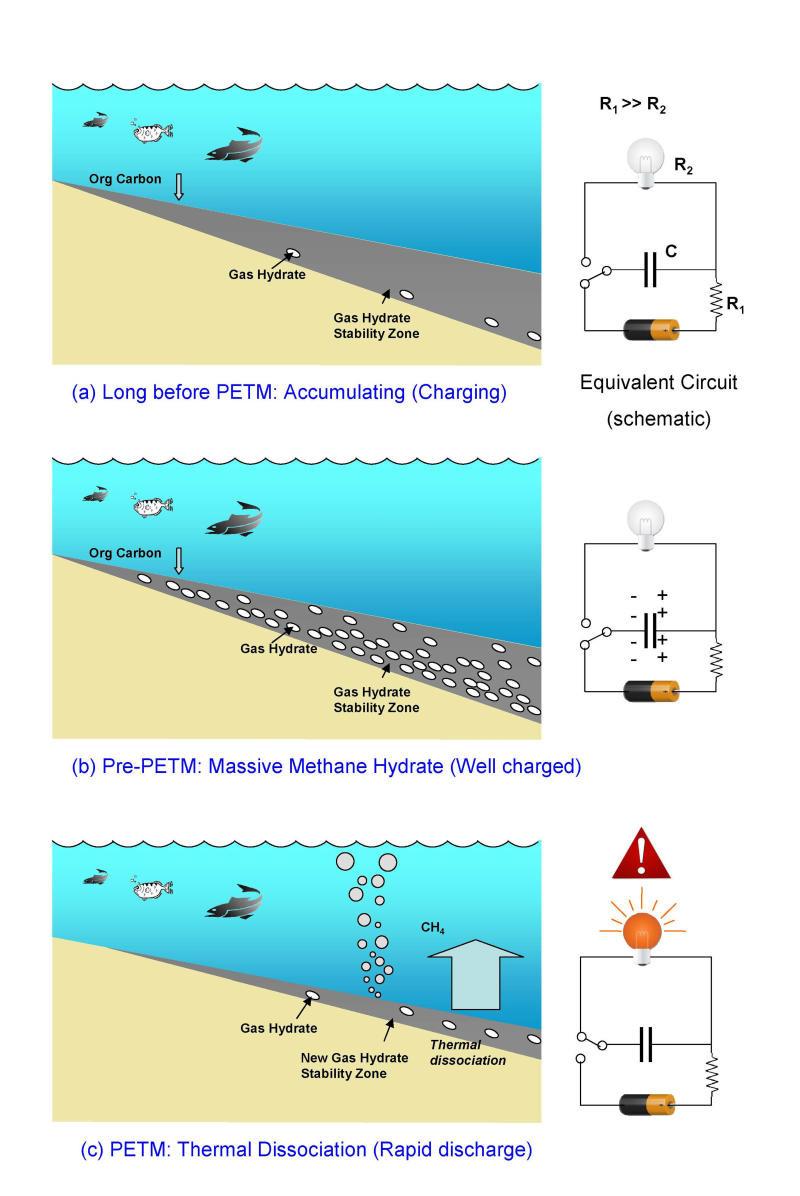There seems to be some uncertainty as to the cause and mechanism for the PETM. In the Science Daily article Methane may be answer to 56-million-year question: Ocean could have contained enough methane to cause drastic climate change (2011) reporting research from Rice University, they claim that the seafloor was already warmer, thus according to their models:
if the oceans were warmer, they would contain less dissolved oxygen and the kinetics for methane formation would have been faster.
With less oxygen to consume organic matter on the way down, more sank to the ocean floor, Gu said, and there, with seafloor temperatures higher than they are today, microbes that turn organic matter into methane work faster.
Thus, they claim, the amount methane in the form of clathrates would have been approximately the same amount as today, but in a thinner stability zone. They are not clear about what caused the destabilisation, but made the analogy of a charging-discharging capacitor (shown below, from the same source):

A recent article A seasonality trigger for carbon injection at the Paleocene–Eocene
Thermal Maximum (Eldrett et al. 2014) details of research into what vegetation eisted at the time to determine the species that were present in the time leading up to the PETM (or CIE = Carbon Isotope Excursion), they found that the seasons were already becoming warmer prior to the CIE (which led to the PETM). The reason for the seasonal warming trend is modelled by the authors as being due to
enhanced seasonal contrasts through Milankovitch forcing
(Lourens et al., 2005)*, combined with a gradually warming
late Paleocene to early Eocene, forced a non-linear response
in ocean circulation to warm intermediate waters.
Implying that orbital influences may have had a role in causing the increased seasonal warming leading up to the CIE.
They conclude that the modelled seasonal extremes prior to the onset of the CIE
represent the smoking gun of a climatologically forced
threshold in the carbon cycle that caused the PETM.
Essentially by destabilising and altering the stability zone (as shown in the diagram above).
Your question about the Cretaceous raises an important point presented in the earlier article Beyond methane: Towards a theory for the Paleocene–Eocene
Thermal Maximum (Higgins and Schrag, 2006), who suggested that the carbon released from methane clathrates would not have been sufficient for the warming experienced during the PETM.
High global sea-level
and flooded continental interiors in the Cretaceous and
early Tertiary may have also reduced the export of
organic carbon from the shelves to the continental slope
by promoting sedimentation on continental shelves that
were 75% larger than present
suggesting that there was not enough methane clathrate, that it was 'building up' during the Cretaceous and early Palaeogene.

